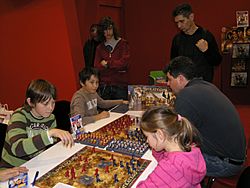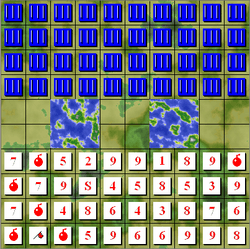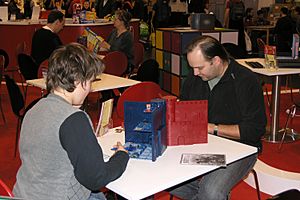Stratego facts for kids

A game of Stratego in session
|
|
| Years active | 1946–present |
|---|---|
| Genre(s) | Board game Strategy game War game |
| Players | 2 |
| Setup time | 2 to 10 minutes |
| Playing time | 15 minutes to 2 hours |
| Random chance | Some |
| Skill(s) required | Strategy, tactics, memory, bluff |
Stratego (pronounced strə-TEE-goh) is an exciting strategy board game for two players. It's played on a board with 100 squares, like a battlefield! Each player commands an army of 40 pieces, which look like different soldiers and officers.
The main goal of Stratego is to find and capture your opponent's secret Flag. You can also win by capturing so many enemy pieces that your opponent can't make any more moves. The rules are simple enough for younger kids to learn, but the game has deep strategies that even adults enjoy.
Stratego is based on an older French game called L'Attaque. It has been made in Europe since World War II and in the United States since 1961. Today, you can find different versions of Stratego, including games for two or four players, and versions with different numbers of pieces.
The International Stratego Federation is the main group that manages the game. They even host a yearly Stratego World Championship!
Contents
- What Does the Name Stratego Mean?
- What Comes in a Stratego Game Box?
- How Do You Set Up a Game of Stratego?
- How Do You Play Stratego?
- Stratego Pieces and Their Powers
- Stratego on Computers and Online
- Other Games Like Stratego
- Different Versions of Stratego
- Stratego Competitions and Tournaments
- See also
What Does the Name Stratego Mean?
The name Stratego comes from the French or Greek word strategos. This word means "leader of an ancient army" or "first general." It's a fitting name for a game about army leaders!
The name Stratego was first officially registered in 1942 in the Netherlands. Today, Jumbo Games owns the trademark for Stratego. They license the game to other companies like Milton Bradley and Hasbro.
What Comes in a Stratego Game Box?
A typical Stratego game box includes:
- 40 red playing pieces, often with gold designs.
- 40 blue playing pieces, often with silver designs.
- A folding cardboard game board, which is about 15.5 by 18.5 inches (39 by 47 cm). It has a 10x10 grid of squares.
- Instructions on how to play.
Older versions of the game had painted wooden pieces, but newer ones usually have colored plastic pieces. The pieces are small, about 1 inch (2.5 cm) tall. Some modern versions have cylindrical, castle-shaped pieces. Some sets even include a cardboard screen to help players set up their pieces without their opponent seeing.
How Do You Set Up a Game of Stratego?
First, players choose their army color, usually red or blue. Before the game starts, each player secretly arranges their 40 pieces on their side of the board. You place your pieces in a 4x10 area.
The ranks of the pieces are printed on only one side. This means you can't see what your opponent's pieces are! Players cannot place pieces in the two "lakes" or the 12 squares in the middle of the board. How you set up your pieces is a big part of your strategy and can really affect the game's outcome.
How Do You Play Stratego?
Players take turns moving one piece at a time. The red player usually moves first. You must move a piece on your turn; you can't skip a turn.
There are two 2x2 areas in the middle of the board that pieces cannot enter. These are like lakes or obstacles on the battlefield. They make it harder to attack directly across the board.
You win the game by capturing your opponent's Flag or by capturing all their movable pieces. Sometimes, pieces can get stuck behind Bomb pieces and can't move.
Stratego is a complex game with many possible moves. However, unlike games like chess, most moves in Stratego are not super critical.
Rules for Moving Pieces
Most movable pieces can only move one square at a time. They can move up, down, left, or right, but not diagonally. You can't move a piece onto a square already taken by one of your own pieces. Bomb and Flag pieces cannot move at all.
The Scout piece is special! It can move any number of spaces in a straight line, like a rook in chess. In older versions, a Scout couldn't move and attack in the same turn, but in newer versions, it can.
You can't move a piece back and forth between the same two squares for more than three turns in a row. Also, a piece cannot endlessly chase another piece it can't capture.
How Do Pieces Attack?
When you want to attack, you move your piece onto a square occupied by an opponent's piece. Both players then show their pieces' ranks. The piece with the lower rank is removed from the board. If both pieces have the same rank, both are removed.
Two special pieces have unique attack powers:
- The Bomb: This piece is very powerful! It destroys any other piece that attacks it, but the Bomb itself is not removed. Only a Miner piece can safely remove a Bomb.
- The Spy: This piece is tricky! It can capture the highest-ranked piece, the Marshal, but only if the Spy attacks first. If the Spy attacks any other piece, or if any piece attacks the Spy (even the Marshal), the Spy is defeated.
After an attack, the winning piece usually moves into the space where the losing piece was.
Keeping Track of the Game
In competitive Stratego, players usually don't write down their moves like in chess. The game is fast-paced, and players keep their starting setups secret, which makes recording difficult.
However, if you play Stratego online, the computer can record your game. It uses a system like "major B2xcaptain B3" to show moves and attacks.
Game Strategy
Unlike chess, Stratego is a game of incomplete information. This means you don't know what all your opponent's pieces are. This leads to fun strategies like:
- Concealment: Hiding your important pieces.
- Bluffing: Making your opponent think a low-ranked piece is a high one.
- Lying in wait: Setting traps for your opponent.
- Guessing: Trying to figure out what your opponent's pieces are.
Stratego Pieces and Their Powers
Each player has 40 pieces. Six of these are Bombs and one is the Flag; these pieces cannot move. The other 33 pieces can move around the board. The Scout is the only piece that can move more than one square at a time.
Here are the classic pieces, from highest rank to lowest:
| Rank | Piece | Number per player | Special properties |
|---|---|---|---|
| B | Bomb | 6 | Cannot move; captures any piece that attacks it (except a Miner). |
| 10/1 | Marshal | 1 | Highest rank; can be captured by the Spy if the Spy attacks first. |
| 9/2 | General | 1 | |
| 8/3 | Colonel | 2 | |
| 7/4 | Major | 3 | |
| 6/5 | Captain | 4 | |
| 5/6 | Lieutenant | 4 | |
| 4/7 | Sergeant | 4 | |
| 3/8 | Miner | 5 | Can defuse (capture) Bombs. |
| 2/9 | Scout | 8 | Moves any distance in a straight line (horizontal or vertical). |
| 1/S | Spy | 1 | Captures the Marshal, but only if the Spy attacks first. |
| F | Flag | 1 | Cannot move; capturing the opponent's Flag wins the game. |
The higher-ranked piece always captures the lower-ranked piece, unless a special rule applies (like with the Bomb or Spy).
Some versions of Stratego (mostly those made after 2000) use '10' as the highest rank for the Marshal and '1' for the Spy. Older versions and the "Nostalgia" edition use '1' for the Marshal and 'S' for the Spy. European versions often use lower numbers for higher ranks, while American versions use higher numbers for higher ranks.
Different Kinds of Pieces
Some versions of Stratego have different pieces with special moves. These can include the Cannon, Archer, Spotter, Infiltrator, Corporal, and Cavalry Captain. In some games, mobile pieces can even "carry" the Flag.
Other versions, like Stratego Waterloo, have completely different pieces and rules. These are almost like new games!
Stratego on Computers and Online
In 1990, a computer version of Stratego was made for Microsoft DOS. It wasn't very good at playing the game back then! Today, there are much better computer players (called AIs), but they are still not as good as the best human players.
In 1998, Hasbro Interactive released a Stratego CD-ROM for Windows computers. You could play it with friends over a network or the internet.
Since 2013, Jumbo and Keesing Games have offered stratego.com, a website where you can play Stratego online for free against other players. It has become a very popular place for Stratego fans!
Other Games Like Stratego
Stratego and its older French version, L'Attaque, have inspired many other games. Two Chinese games from the 20th century are similar: "Game of the fighting animals" (Dou Shou Qi), also known as Jungle or "Animal Chess", and Land Battle Chess (Lu Zhan Qi).
The game Jungle also has pieces with different ranks (but they are animals instead of soldiers). The board, with two lakes in the middle, is very similar to Stratego. The main differences are that in Jungle, pieces are not hidden, and their starting positions are always the same.
A more complex Chinese game called Land Battle Chess (Lu Zhan Qi) is also related to Stratego. It's played on a 5x13 board with special un-occupiable spaces. Each player has 25 pieces. Like Stratego, players hide their pieces, and the goal is to capture the enemy's flag. This game has extra features like "missile" pieces and a board with railroads and "camps." Sometimes, a third person acts as a referee to decide battles without revealing piece identities.
Other games inspired by Stratego include:
- Tri-tactics: A game from the 1950s that combined L'Attaque with naval and air battles.
- Game of the Generals: A Philippine version of Stratego from 1973, played on a different board.
- battle for the temple: An Israeli game.
There's even a real-life capture the flag game called "Stratego" played at summer camps! Two teams of many players are given different ranks (like in the board game). Players can tag and capture lower-ranked opponents, but the lowest rank can capture the highest. Players don't always know who is on their team, which adds to the fun and bluffing!
Different Versions of Stratego
Stratego is still being made today, with new versions coming out often. Here are some notable ones:
Classic Stratego Versions
These versions usually have the 10x10 board and 40 pieces per side, following the original rules.
- Official Modern Version (Stratego Original): This version has updated artwork and "castle-like" plastic pieces. You usually have to put stickers on the pieces yourself. The rank numbering is often in the European style (higher numbers mean higher rank). It sometimes includes an extra piece called the Infiltrator.
- Stratego 50th Anniversary: Released in 1997, this version came in special boxes (like a book or a metal tin). It had the original artwork and gameplay. It sometimes included optional Cannon pieces.
- Nostalgia Game Series Edition: From 2002, this version aimed to feel like the classic game with traditional pieces and numbering. It often came in a wooden box.
- Library Edition: Hasbro's version that looks like a book, designed to fit on a bookshelf.
- Michael Graves Design Stratego: A special edition from 2002 with a finished wood box and unique black and white pieces.
- Stratego Onyx: Released in 2008, this version had wooden pieces with foil designs and a fancy raised gameboard.
- Franklin Mint Civil War Collector's Edition: A very fancy version from the 1990s with a Civil War theme and gold- and silver-plated pieces. It was rarely sold due to licensing issues.
Variant Stratego Versions
These versions have big differences in how they are played, like different board sizes or rules.
- Ultimate Stratego: This version could be played by up to 4 players at once. It included four different ways to play: "Ultimate Lightning", "Alliance Campaign", "Alliance Lightning", and "Ultimate Campaign".
- Science Fiction Version: A version with a futuristic space theme. It's played on a smaller 8x10 board with 30 pieces per player and includes unique Spotter pieces.
- Stratego Waterloo: Released in 2015 for the 200th anniversary of the Battle of Waterloo. Instead of ranks, pieces represent historical units from the battle. The goal is to get two of your pieces onto your opponent's communication lines, not capture a flag.
- Stratego Conquest: From 1996, this game for 2 to 4 players was played on a world map and included cannons and cavalry.
- Stratego Fortress: A cool 3D version with a three-level fortress and mystical-themed pieces.
- Fire and Ice Stratego: This Hasbro version has a fantasy theme with magical and mythological pieces that have special powers. It's played on a smaller 8x10 board with 30 pieces per player.
Themed Stratego Versions
Many Stratego games have been made with popular movie or comic book themes:
- The Lord of the Rings (2004)
- Star Wars (2002)
- Star Wars: The Clone Wars (2009)
- Chronicles of Narnia (2005)
- Pirates of the Caribbean (2007)
- Marvel Comics (2007)
- Transformers (2007)
- Sharpe's Attack (1996)
- Duel Masters (2004)
Produced by Avalon Hill:
- Stratego: Legends (1999)
Produced by USAopoly:
- Democrats vs Republicans Stratego (2008)
- Civil War Stratego (2007)
Stratego Competitions and Tournaments
Stratego is a very competitive game, and its popularity in tournaments has grown over the years. Many Stratego competitions are held around the world, especially in the Netherlands, Germany, Greece, and Belgium. Players from the Netherlands have often done very well in international Stratego events.
Stratego World Championships have been held every year since 1997, usually in August.
Competitive Stratego is played in four main versions:
- Classic Stratego: This is the original game. Competitions include the "Classic Stratego World Championships" and "Classic Stratego Olympiad."
- Ultimate Lightning Stratego: In this faster version, each side has only 20 pieces. Games are much quicker than Classic Stratego.
- Duel Stratego: Played with 10 pieces per side on an 8x10 board. The first "Stratego Duel World Championships" were held in 2009.
- Stratego Barrage: This "Quick-Stratego" version was created for tournaments to help decide winners faster. Players set up their 8 pieces (Flag, Marshal, General, 1 Bomb, 1 Miner, 2 Scouts, and Spy) in one minute and play in five minutes.
World Championships Winners
Here are some of the past winners of the Classic Stratego World Championships:
| Year | Host City | Gold Winner | Silver Winner | Bronze Winner |
|---|---|---|---|---|
| 1997 | ||||
| 1998 | ||||
| 1999 | ||||
| 2000 | ||||
| 2001 | ||||
| 2002 | ||||
| 2003 | ||||
| 2004 | ||||
| 2005 | Not held | |||
| 2006 | ||||
| 2007 | ||||
| 2008 | ||||
| 2009 | ||||
| 2010 | ||||
| 2011 | ||||
| 2012 | ||||
| 2013 | ||||
| 2014 | ||||
| 2015 | ||||
| 2016 | ||||
| 2017 | ||||
| 2018 | ||||
| 2019 |
Other Stratego Tournaments
- First Dutch Championship (1991): The first national Stratego championship in the Netherlands had over 100 players!
- Cambodian Championships (1997, 1998): Cambodia was the first Asian country to host a national Classic Stratego Championship.
- World Team Cup (2007): Teams of four players compete for their country. In 2007, the Netherlands beat Germany.
- Stratego Olympiad (2007): Part of the Mind Sports Olympics, this event included the Barrage (Quick-Stratego) World Title.
- Stratego World Team Championship (2007): Another team event where Great Britain defeated the Netherlands.
- Computer Stratego World Championship (2007-2010): Tournaments for computer programs that play Stratego. The program "Probe" won several times.
- 2010 Stratego World Championship: Held in Maastricht, Netherlands. Pim Neimejer won the overall championship. Lady Kathryn Whitehorn won the Women's Stratego World Championship.
See also
 In Spanish: Stratego para niños
In Spanish: Stratego para niños



